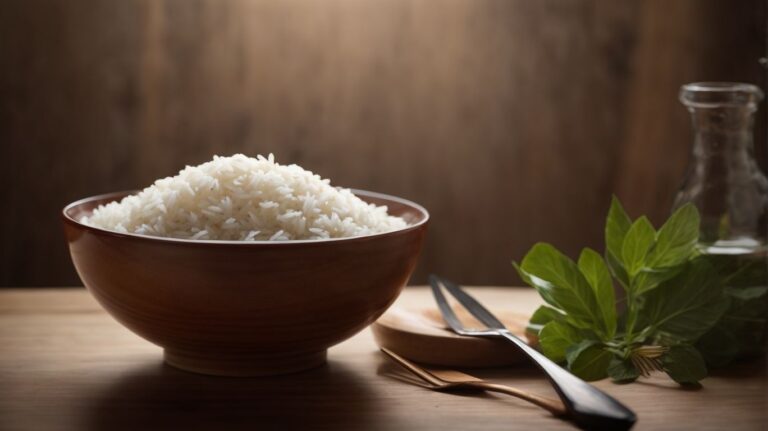How to Cook Quinoa for Soup?
Curious about quinoa and its benefits? Looking to add this nutritious grain to your soup recipes?
We will explore what quinoa is, its benefits, and provide a step-by-step guide on how to cook quinoa for soup.
From rinsing to fluffing, we’ve got you covered. Plus, we’ll share some tips and tricks to enhance the flavor and nutritional value of your soups.
Stay tuned for a delicious and healthy addition to your culinary repertoire!
Key Takeaways:
What is Quinoa?
Quinoa is a versatile and nutritious grain-like seed that has gained popularity for its exceptional health benefits and culinary versatility.
Originally cultivated by the Incas in the Andean region of South America, quinoa has been consumed for thousands of years for its high nutritional value. Packed with protein, fiber, and essential vitamins and minerals such as magnesium, manganese, and iron, it is considered a superfood for its health-promoting properties.
When preparing quinoa, it is important to rinse it thoroughly to remove its natural coating of saponins which can cause a bitter taste. Cooking quinoa is simple and quick, requiring just two parts water to one part quinoa. It can be used as a base for salads, soups, stir-fries, and even as a breakfast cereal alternative.
One popular way to enjoy quinoa is by making a colorful and nutritious quinoa salad with fresh vegetables, herbs, and a zesty dressing. Another favorite is to use it as a filling for stuffed peppers or as a side dish alongside roasted vegetables.
What Are the Benefits of Quinoa?
The benefits of quinoa include being a rich source of plant-based protein, offering a unique texture, flavor profile, and providing essential nutrients for a balanced diet.
Quinoa stands out as a nutritional powerhouse due to its high protein content, making it an excellent choice for vegetarians and vegans seeking plant-based protein alternatives. Its well-balanced amino acid profile complements a wide range of diets, aiding in muscle repair and growth. The diverse texture variations of quinoa, ranging from fluffy to crunchy, add a delightful element to dishes and salads.
Not only does quinoa deliver on the protein front, but it also boasts a nutty and slightly earthy flavor that pairs well with various ingredients, enhancing the overall taste of meals. This ancient grain is loaded with essential nutrients like iron, magnesium, and fiber, promoting optimal health and well-being. Including quinoa in your diet can significantly contribute towards a healthier lifestyle, offering a plethora of benefits in every nutritious bite.
How to Cook Quinoa for Soup?
Cooking quinoa for soup involves a simple yet flavorful process that enhances the heartiness of the dish while infusing it with nutritious ingredients and robust flavors.
When selecting quinoa for soup, opt for either white or red quinoa, as they hold their shape well when cooked and offer a slightly nutty flavor that complements soups perfectly.
Next, rinse the quinoa under cold water to remove any bitterness. Use a fine-mesh strainer for this process to ensure thorough washing.
For cooking, the ideal ratio is 1 part quinoa to 2 parts liquid. You can use vegetable broth for added depth of flavor or water for a more neutral base.
Bring the liquid to a boil, add the quinoa, cover, and simmer for about 15 minutes until the quinoa is tender and has absorbed the liquid.
Step 1: Rinse the Quinoa
To start cooking quinoa for soup, the first step is to thoroughly rinse the quinoa under cold water to remove any residue or bitterness.
Rinsing quinoa before cooking is a crucial step that can greatly enhance the overall taste and texture of your dish. When you rinse the quinoa, you are effectively washing away the natural coating called saponin, which can impart a bitter flavor if not removed. By rinsing the quinoa, you ensure that it cooks up light, fluffy, and with a clean, nutty flavor.
Step 2: Measure the Quinoa and Water
Accurately measuring the quinoa and water ratio is crucial for achieving the perfect texture and consistency in your soup.
Regarding preparing a delicious quinoa soup, the quinoa-to-water ratio plays a vital role in determining the final outcome. Too much water can result in a mushy and bland dish, while too little water may lead to undercooked quinoa. To strike the right balance, a common rule of thumb is to use a 1:2 ratio of quinoa to water. Depending on the desired thickness of your soup, you can adjust this ratio slightly.
Measuring the ingredients accurately using a measuring cup or scale is essential to ensure consistency in every batch. Rinsing the quinoa before cooking helps remove any bitter taste and ensures a cleaner flavor profile in your soup.
Step 3: Bring the Water to a Boil
Once you’ve measured the water, bring it to a rapid boil in a pot or saucepan before adding the quinoa for cooking.
When boiling water for quinoa, it’s crucial to use a pot or saucepan that allows for ample space for the water to reach its boiling point quickly. This rapid boiling process ensures that the quinoa cooks evenly and retains its nutritional value. Choose a cooking vessel with a tight-fitting lid to keep the steam inside, aiding in the efficient cooking of the quinoa.
Safety should always be a top priority when boiling water. Remember to handle the hot pot or saucepan with caution, using oven mitts or a kitchen towel to prevent burns. Be mindful of the steam that escapes when removing the lid, as it can cause burns if not approached carefully. By following these steps, you’ll master the art of boiling water for perfect quinoa every time.
Step 4: Add the Quinoa to the Boiling Water
Carefully add the rinsed quinoa to the boiling water, ensuring even distribution and gentle stirring to prevent clumping or sticking.
Once the quinoa has been added to the boiling water, reduce the heat to a gentle simmer and cover the pot with a lid to allow the quinoa to cook undisturbed. It’s crucial not to lift the lid during the cooking process as it may disrupt the steaming and lead to uneven cooking.
Throughout the cooking duration, occasional stirring may be necessary to prevent the quinoa from sticking to the bottom of the pot. It’s essential to do so with a light touch, ensuring the grains remain fluffy and separate.
Proper heat management is key to achieving perfectly cooked quinoa. Maintaining a consistent simmer without vigorous boiling helps the quinoa absorb the water evenly, resulting in a light, fluffy texture.
Step 5: Reduce the Heat and Simmer
After adding the quinoa, reduce the heat to a gentle simmer, cover the pot, and let it cook undisturbed to allow the quinoa to absorb the liquid and cook evenly.
Simmering quinoa is a crucial step in achieving that perfect fluffy texture and nutty flavor. Maintaining a gentle simmer prevents the quinoa from cooking too quickly or sticking to the bottom of the pot. The lid plays a vital role in trapping the steam, ensuring that the quinoa cooks through evenly.
Adjusting the temperature is key; a rapid boil can lead to overcooked quinoa or a mushy consistency. By simmering the quinoa, you give it the time it needs to swell and become tender without becoming soggy.
Depending on the type of quinoa and desired texture, the cooking duration typically ranges from 15 to 20 minutes. This allows the quinoa to absorb the liquid completely while still retaining a slight bite.
Step 6: Check the Quinoa for Doneness
To ensure that the quinoa is perfectly cooked for the soup, check its doneness by fluffing it with a fork and examining its texture and tenderness.
One of the key visual cues to look for is when the quinoa grains have absorbed the liquid and expanded, indicating that they are cooked through. The quinoa should be slightly translucent with a white germ that appears around the seed. Taste-testing a few grains can also help determine if the quinoa is soft and has a pleasant, slightly nutty flavor.
Step 7: Let the Quinoa Rest
Allow the cooked quinoa to rest off the heat for a few minutes to stabilize its texture and flavors before incorporating it into your soup recipe.
Letting quinoa rest after cooking is a crucial step that many overlook but can significantly enhance the overall dish. During this rest period, the quinoa continues to absorb any remaining liquid, resulting in a more uniform texture. Not only does resting help the quinoa reach its full fluffy potential, but it also gives the grains time to cool slightly, which can make them easier to handle and incorporate into your recipe.
The resting period allows the flavors of the quinoa to meld together harmoniously. The subtle nuttiness and earthy notes of quinoa are given a chance to develop and intensify, enhancing the taste of your final dish. The resting process helps in achieving the ideal temperature for serving, ensuring that the quinoa is not too hot and doesn’t overpower other ingredients.”
Step 8: Fluff the Quinoa with a Fork
Using a fork, gently fluff the cooked quinoa to separate the grains and enhance its light and fluffy texture for incorporation into your soup.
Fluffing quinoa with a fork is a crucial step in ensuring that each grain remains distinct and doesn’t clump together. This technique helps distribute any remaining moisture evenly, preventing a mushy or sticky consistency in your soup.
The purpose of fluffing is to aerate the quinoa, allowing it to cool slightly and absorb any excess liquid. This not only improves the overall mouthfeel of your soup but also allows the flavors to meld together harmoniously.
Fluffing also helps achieve a more visually appealing presentation, as the individual grains look more appetizing and retain their shape amidst the broth.
Step 9: Add the Cooked Quinoa to Your Soup Recipe
The final step involves adding the freshly cooked quinoa to your prepared soup recipe, enhancing its nutritional value, texture, and overall heartiness.
When integrating quinoa into soups, it not only contributes a rich source of plant-based protein but also brings a delightful nutty flavor to the dish. The quinoa’s small, spherical shape allows it to blend seamlessly with the other ingredients, infusing the soup with a satisfying chewiness. Quinoa is a versatile ingredient that can complement a variety of flavors, from traditional broths to more exotic spice combinations, making it a great addition to both classic and innovative soup recipes.
Tips and Tricks for Cooking Quinoa for Soup
Enhance your quinoa soup preparation with these tips and tricks that elevate the flavors, textures, and overall experience of your dish.
One excellent way to boost the flavor of your quinoa soup is to experiment with different herbs and spices. Try adding a pinch of smoked paprika for a subtle smokiness or a dash of cumin for a warm, earthy flavor. You can also incorporate fresh herbs like parsley, cilantro, or dill for a burst of freshness.
Another option is to vary the vegetables in your soup. Consider adding sweet potatoes for a touch of sweetness, bell peppers for a pop of color, or mushrooms for umami richness. These additions can add depth and complexity to your dish.
For a creamy twist, you can stir in a dollop of coconut milk or Greek yogurt towards the end of cooking to create a luscious, velvety texture. This can add a touch of richness and creaminess to your quinoa soup without overpowering the other flavors.
Tip 1: Use Chicken or Vegetable Broth for More Flavor
For enhanced flavor in your quinoa soup, consider using chicken or vegetable broth as a base to infuse your dish with rich and savory notes.
Broths are not only flavorful additions but also provide a depth of taste that elevates the overall profile of the soup. Chicken broth, with its hearty essence, lends a robust flavor, while vegetable broth adds a lighter, more delicate touch. These broths not only enhance the taste but also contribute essential nutrients to your meal.
By choosing quality broth options, you can create a hearty and nutritious quinoa soup. Pairing suggestions such as adding fresh herbs like cilantro or thyme, along with a squeeze of lemon, can further enhance the flavors and create a balanced culinary experience.
Tip 2: Add Quinoa to Your Soup for Extra Protein and Fiber
Incorporating quinoa into your soup not only boosts its protein and fiber content but also adds a delightful texture and nutritional depth to your meal.
Quinoa is a complete protein source, containing all nine essential amino acids, making it an excellent choice for vegetarians and vegans. The high fiber content in quinoa aids in digestion and helps you feel full longer, promoting weight management.
Adding quinoa to soups not only improves the nutritional profile but also enhances the texture, providing a satisfying chewiness and nutty flavor. Quinoa is a gluten-free grain, suitable for individuals with gluten sensitivities or celiac disease.
Frequently Asked Questions
What is quinoa and how do I use it in soup?
Quinoa is a small, protein-packed grain that is perfect for adding to soups for extra nutrition and texture. To use quinoa in soup, simply cook it according to package instructions and add it to your soup towards the end of the cooking process.
Can I use any type of quinoa for soup?
Yes, you can use any type of quinoa for soup, including white, red, and black varieties. Just be sure to rinse the quinoa before cooking to remove any bitter coating.
How long does it take to cook quinoa for soup?
On average, quinoa takes about 15-20 minutes to cook for soup. However, cooking time may vary depending on the type of quinoa and the desired texture.
Do I need to pre-cook quinoa before adding it to soup?
No, you do not need to pre-cook quinoa before adding it to soup. Quinoa will cook perfectly in the soup broth and absorb all of the flavors.
Can I make quinoa soup ahead of time?
Yes, you can make quinoa soup ahead of time. Cook the quinoa separately and store it in an airtight container. When ready to serve, reheat the soup and add the cooked quinoa.
What are some tips for making the best quinoa soup?
To make the best quinoa soup, be sure to cook the quinoa separately and add it towards the end of the cooking process to avoid it becoming mushy. Also, don’t be afraid to experiment with different flavor combinations and add in plenty of vegetables for a hearty and nutritious soup.





